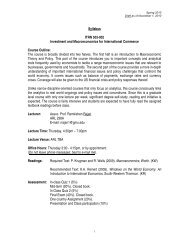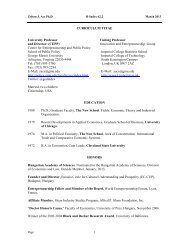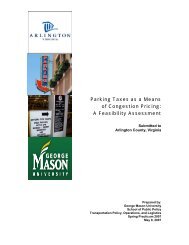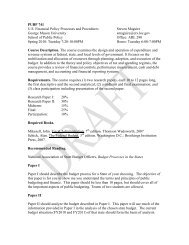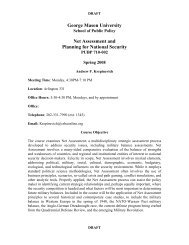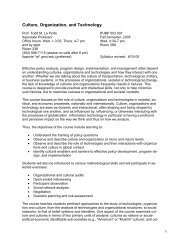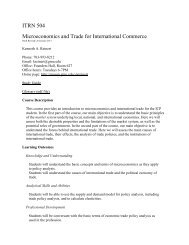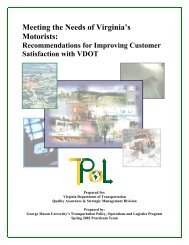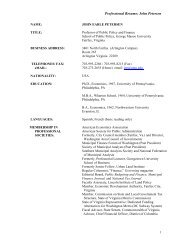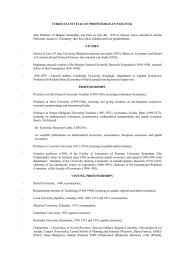Cost Benefit Analysis of Washington-Richmond High-Speed Rail
Cost Benefit Analysis of Washington-Richmond High-Speed Rail
Cost Benefit Analysis of Washington-Richmond High-Speed Rail
Create successful ePaper yourself
Turn your PDF publications into a flip-book with our unique Google optimized e-Paper software.
<strong>Cost</strong> <strong>Benefit</strong> <strong>Analysis</strong> <strong>of</strong> <strong>Washington</strong>-<strong>Richmond</strong> <strong>High</strong>-<strong>Speed</strong> <strong>Rail</strong> Spring 2010<br />
34<br />
Year Passenger Mile <strong>Cost</strong> Train Mile <strong>Cost</strong><br />
2015 $3,192,178.64 $7,809,840.86<br />
2016 $4,029,468.15 $8,356,529.72<br />
2017 $5,075,969.44 $8,941,486.81<br />
2018 $6,383,300.53 $9,567,390.88<br />
2019 $8,015,974.81 $10,237,108.24<br />
2020 $10,054,735.37 $10,953,705.82<br />
2021 $12,600,801.06 $11,720,465.23<br />
2022 $15,781,293.57 $12,540,897.79<br />
2023 $19,756,202.33 $13,418,760.64<br />
2024 $24,727,363.34 $14,358,073.88<br />
2025 $30,950,092.39 $15,363,139.06<br />
2026 $38,748,341.28 $82,192,793.95<br />
2027 $48,534,565.71 $87,946,289.53<br />
2028 $60,835,948.95 $94,102,529.79<br />
2029 $76,329,279.65 $100,689,706.88<br />
2030 $88,186,710.14 $107,737,986.36<br />
2031 $101,862,414.46 $115,279,645.40<br />
2032 $117,630,765.41 $123,349,220.58<br />
2033 $135,806,657.49 $131,983,666.02<br />
2034 $156,751,307.25 $141,222,522.64<br />
2035 $180,878,842.48 $151,108,099.23<br />
Table 5-2: Increased Operating <strong>Cost</strong>s by Passenger Mile and Train Mile<br />
Fare revenues and expected subsidy were calculated using the additional operating costs based on train<br />
miles and fares as projected in the ridership model. Figures 5-2 and 5-3 below, show the comparison<br />
for train miles and passenger miles, respectively. The initial subsidy per passenger is estimated to be<br />
$218 36 . It should be noted that this subsidy estimate does not include the cost <strong>of</strong> rolling stock, which<br />
would likely be provided by Amtrak. Due to the constraints <strong>of</strong> this study’s scope, this analysis takes into<br />
account only trips between <strong>Washington</strong> and <strong>Richmond</strong>. Once the corridor is connected to other HSR<br />
corridors it is likely that the ridership and passenger miles traveled will increase. The per-passenger<br />
mile operating cost and required subsidy would decrease as the ridership in the corridor increases. It is<br />
likley that operating costs would be less if the full ridership, including through traffic, was included in<br />
the analysis. Because this additional traffic is not included in the analysis, it might be more useful to<br />
calculate the subsidy based on passenger mile. This analysis assumes the system-wide average $0.554<br />
per passenger mile operating cost. If the full ridership data information becomes available it would be<br />
beneficial for future studies to address this issue and adjust the passenger mile operating cost rate<br />
according to overall ridership.<br />
36 See Appendix C for the full table <strong>of</strong> results <strong>of</strong> this analysis.



